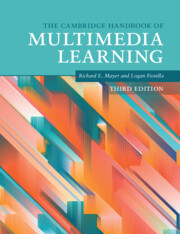Book contents
- The Cambridge Handbook of Multimedia Learning
- The Cambridge Handbook of Multimedia Learning
- Copyright page
- Contents
- Figures
- Tables
- Contributors
- Preface
- Acknowledgments
- Part I Background
- Part II Theoretical Foundations
- Part III Basic Principles of Multimedia Learning
- Part IV Principles for Reducing Extraneous Processing in Multimedia Learning
- Part V Principles for Managing Essential Processing in Multimedia Learning
- Part VI Principles Based on Social and Affective Features of Multimedia Learning
- 22 Principles Based on Social Cues in Multimedia Learning
- 23 The Embodiment Principle in Multimedia Learning
- 24 The Immersion Principle in Multimedia Learning
- 25 The Collaboration Principle in Multimedia Learning
- 26 The Animation Composition Principle in Multimedia Learning
- 27 The Emotional Design Principle in Multimedia Learning
- Part VII Principles Based on Generative Activity in Multimedia Learning
- Part VIII Multimedia Learning with Media
- Author Index
- Subject Index
- References
27 - The Emotional Design Principle in Multimedia Learning
from Part VI - Principles Based on Social and Affective Features of Multimedia Learning
Published online by Cambridge University Press: 19 November 2021
- The Cambridge Handbook of Multimedia Learning
- The Cambridge Handbook of Multimedia Learning
- Copyright page
- Contents
- Figures
- Tables
- Contributors
- Preface
- Acknowledgments
- Part I Background
- Part II Theoretical Foundations
- Part III Basic Principles of Multimedia Learning
- Part IV Principles for Reducing Extraneous Processing in Multimedia Learning
- Part V Principles for Managing Essential Processing in Multimedia Learning
- Part VI Principles Based on Social and Affective Features of Multimedia Learning
- 22 Principles Based on Social Cues in Multimedia Learning
- 23 The Embodiment Principle in Multimedia Learning
- 24 The Immersion Principle in Multimedia Learning
- 25 The Collaboration Principle in Multimedia Learning
- 26 The Animation Composition Principle in Multimedia Learning
- 27 The Emotional Design Principle in Multimedia Learning
- Part VII Principles Based on Generative Activity in Multimedia Learning
- Part VIII Multimedia Learning with Media
- Author Index
- Subject Index
- References
Summary
Emotional Design is the deliberate use of design elements of learning materials to induce an emotional state in the learner that leads to increased learning outcomes. This emotion induction should not add significantly to the cognitive demands placed on the learner, which is best achieved by using existing design elements rather than adding new elements. In this chapter, we summarize research on the effect of emotion-inducing features of a multimedia lesson on memory, cognition, and learning, provide empirical evidence for the emotional design principle, and discuss design features that have been shown to induce emotion. We will also differentiate emotional design from other emotion induction methods that increase processing demands on the learner by adding seductive details or that take place outside of the learning materials in the form of priming.
Keywords
Information
- Type
- Chapter
- Information
- The Cambridge Handbook of Multimedia Learning , pp. 324 - 336Publisher: Cambridge University PressPrint publication year: 2021
References
Accessibility standard: Unknown
Why this information is here
This section outlines the accessibility features of this content - including support for screen readers, full keyboard navigation and high-contrast display options. This may not be relevant for you.Accessibility Information
- 4
- Cited by
